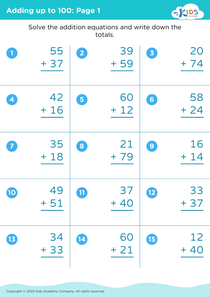Pattern recognition Adding up to 1000 Worksheets for 8-Year-Olds
3 filtered results
-
From - To
Unlock the power of math with our engaging "Pattern Recognition Adding Up to 1000 Worksheets" designed for 8-year-olds. These worksheets foster essential skills in identifying patterns and understanding numerical relationships, pivotal for mastering addition up to 1000. Each activity is thoughtfully crafted to challenge young learners and enhance their problem-solving abilities while ensuring learning remains fun. With colorful designs and age-appropriate tasks, students will build confidence in their math skills as they recognize and complete patterns in numbers. Ideal for classroom use or at-home practice, these resources will make mastering addition an enjoyable adventure! Get started today and watch your child thrive!
Pattern recognition is a crucial skill for 8-year-olds, particularly when learning to add numbers up to 1000. Parents and teachers should prioritize it because it lays the foundation for advanced mathematical concepts and enhances critical thinking abilities. When children learn to identify patterns in numbers, they develop better problem-solving skills, as they can perceive relationships between numbers rather than treating them as isolated entities.
By recognizing patterns, children can simplify complex addition tasks. For instance, understanding that 500 + 500 equals 1000 can help them recognize similar combinations more easily. This skill not only builds confidence in their arithmetic abilities but also fosters a deeper understanding of the number system, which is essential for future mathematical success.
Moreover, pattern recognition tends to be a fun and engaging activity, allowing children to explore numbers in creative ways. Activities such as identifying patterns in sequences or using building blocks can make learning enjoyable. Ultimately, fostering pattern recognition enhances a child's numerical literacy, a vital skill for academic achievement across all subjects. Thus, parents and teachers should nurture pattern recognition in young learners, setting them on a path to strong mathematical understanding and lifelong learning success.


















